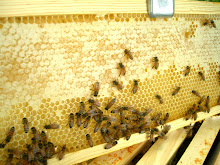On the recommendation of Linda Tillman, a local master beekeeper who maintains a very thorough and informative blog -- and who doesn't mind answering a novice's questions -- I did the "toothpick test" for American Foulbrood. AFB is a spore-producing disease that systematically destroys a hive by infecting the bee larvae. One of the first signs of AFB is sunken capped brood (sometimes with small chew marks in the caps) and "ropey" larvae. The test is simple: insert a toothpick into a capped cell, wiggle it around a bit and pull it out; if the toothpick is slimed with a mucous-like, ropey substance, the hive's infected with AFB. There is usually a foul odor to accompany this.
Thankfully, I found neither ropey larvae nor a foul odor in Sweet Beezus. There was very little capped lavae at all.
 And when I took the supers off and sifted through the dead bees on the screened bottom board, I couldn't find the queen. So, the hive was without a queen for quite some time.
And when I took the supers off and sifted through the dead bees on the screened bottom board, I couldn't find the queen. So, the hive was without a queen for quite some time. In the past, I've always been afraid to keep the hive open for more than a very few minutes in case the queen escaped. One of the most important lessons I've learned from this experience with hive death is that I cannot be afraid to open up the hives all the way down and examine all of the frames once in a while to be certain that there IS a queen and that she's laying eggs.
On the positive side, since there is no evidence of AFB, I can use this hive again. If it had been infected, I would have to burn the frames and at least scorch the insides of all of the hive components, if not burn them all, to make it safe for new bees. Also, according to Linda, I can use the existing frames that already have comb drawn out on them, courtesy of the bees that are now gone. This will make a great home for a new colony because they won't have to work quite as hard to get things going and the queen will have cells ready and waiting for eggs.
I had enough smoke left in the smoker to open one of the other hives for a few minutes, so I took a peek in Rocky. The Rocky girls have been busy eating the fondant and pollen patties, and when I took out some of the frames in the top super, they were LOADED with honey! It's a beautiful golden color and smelled so good. Too bad I can't harvest it for myself, but this is their food source for the winter.



